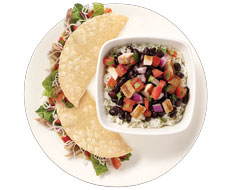Marketing professors over the years have lectured students that they should never give a customer too many choices. Quick-serve operators must have missed that class. A look at several successful quick-serve menus reveals some form of a Choose Two option, where consumers can create a meal by combining items from an array of choices.
“This is a trend that’s here to stay,” says Jobie Dixon, a marketing consultant and former executive with Long John Silver’s. “It’s not new, you see it anytime the economy isn’t doing well and there’s a need to give customers value to get them in the door. But there are other factors at play that show it may become permanent.”
The Choose Two trend in today’s market includes a number of brands offering a selection of smaller-portioned items at a fixed price point. While its objective may be to ultimately add to the bottom line, the offering also provides some less-obvious benefits.
“We found that a majority of our customers had selected favorites and didn’t want to vary from them,” says Ted Stoner, director of strategic product development at the Wheat Ridge, Colorado–based Qdoba Mexican Grill. “We tested our mango salad at a store once and offered it free to people in order to get comments, but they’d say, ‘No thanks, I’m just here to get my burrito.’ From there we thought about how we could get those customers to sample more of the menu.”
In 2008, some in the quick-service industry started to notice that more consumers were looking for smaller portions in order to fit their diet. Many saw it as an opening to introduce consumers to more of their menu.
“We thought, ‘Let’s bring out these smaller portions, but offer two at one price to make experimenting more attractive,’” Stoner says of Qdoba’s Craft 2 menu offering. “From there it just grew.”
Getting customers to branch out was also an issue for McAlister’s Deli, an operation with an extensive menu. Annica Kreider, vice president of marketing for the Ridgeland, Mississippi–based fast casual, says the company’s selection of signature soups was the base from which it decided to grow its Choose Any Two menu option.
“But instead of creating a set menu for them to select from, they can pick from anything on the menu,” she says. “A cup of any soup, half of any sandwich, half of any salad, and so forth. It came out two years ago and it’s still a big part of our menu.”
Creating that simplicity has been a key for McAlister’s and its Choose Any Two option. “Normally these kinds of offerings are done with a side salad or french fries,” Kreider says. “We just thought, ‘Why not let them try anything?’ You can get a salad with protein and half a roast beef sandwich if you’d like, or you can choose something lighter. There are countless combinations.”
Choose Two menus are also attractive to the health-conscious customer. Ellen Kramer, chief communications officer for Quiznos—which has its own Choose 2 option—says chains offering such a pairing help to empower customers in controlling their diet.
“You can say that you don’t have to deprive yourself if you’re getting a smaller portion and another healthy choice to go with it,” Kramer says.
Kreider says McAlister’s Choose Any Two option compliments its 5 Under 500 offering, which includes five meals with less than 500 calories. “People are often amazed at what they can get in our stores for under 500 calories,” she says.
Marketing a Choose Two menu option can be tricky for quick serves. Simply putting the option on the menuboard didn’t work, Stoner says, because customers don’t necessarily look for it there or don’t look at the menu at all, already knowing what they’ll order when they enter. To get around that problem, Qdoba added signage and samples at the point of purchase.
“People actually see what we’re offering and ask, ‘What’s that?’” Stoner says. “We tell them it’s part of our Craft 2 menu, and when they see the product, they’re usually more inclined to try it.”
In order to make the Choose Two concept succeed, experts say there needs to be a simple price point. “Five dollars is commonly accepted as value for a quick-serve meal,” Dixon says. “Subway and Quiznos have had success with their $5 concepts for a long time and it seems to be the accepted norm.”
But the flipside to a lower fixed price point is that Choose Two menu options tend not to be as profitable as a single-meal option. Operators, Dixon says, must be willing to accept that adding the Choose Two to their menu is done more as a marketing technique than it is a bottom-line builder.
“This is what these types of deals are about,” he says. “You’re sacrificing a larger average check for volume. And you’re counting on the Choose Two customer also buying a drink, which helps add profit.”
Not only do Choose Two menu options put a strain on profit building, but they also present operational challenges for participating quick serves. “Obviously you want people to try it, but you don’t want them to hold up the line asking lots of questions while they try to decide,” Stoner says. “The other thing is that your staff needs to build two items instead of just one for these customers, which can take extra time, and you’ve got to make sure that the quality is still high. We worked these out with our store managers early on, and we’ve been able to get past them.”
Despite the challenges of the Choose Two, Dixon expects the trend to catch on with more concepts and says it could be a quick-serve staple for years to come.
“It’s logical and it fits with trying to attract women and people shopping for lighter meals,” he says. “It may become like the $1 menu concept, something that’s always in the corner of the menu that you can highlight when you need to.”











